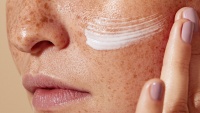The latest viral skincare trend may have an off-putting name, but thankfully it has little to do with molluscs. Known as "slugging", this technique could be the secret to achieving bouncy, well-moisturised skin. "Slugging has been trending online for years as a cure-all for dehydrated and irritated skin," said Cosmopolitan .
The practice "became known as slugging on skin care TikTok because the vast layers of Vaseline resemble the slimy substance that keeps snails hydrated and moist," said skincare blog The Klog . And while the name might deter some, it is a fairly straightforward skincare method. A snail as old as time "Slugging, which originates from the K-beauty world, involves applying a thin layer of occlusive ointment, like Vaseline or Aquaphor, on your face to help prevent water loss," said dermatologist Adarsh Vijay Mudgil, speaking to the magazine.

The name "slugging" stems from the "ultra-shiny and slimy" appearance Vaseline or an occlusive ointment gives your skin, making it look as though "a slug made its way across your face", said the magazine. Although the skincare trend may have gained popularity online only in the past few years, it has actually been around for "millennia" in many regions across the globe, said National Geographic . The technique is "nothing new to Black American women", who have used it for generations before specialised products were available, said the magazine, while "oil as a balm dates back to ancient Egyptians who used it to reduce wrinkles".
Similarly, in 15th-century North America, "the Seneca tribe used oil seeping from the ground in northwestern Pennsylvania to soften animal skins as well as their own". The final step in your skincare routine Slugging is simple: apply an occlusive ointment as the final step in your skincare routine to lock in moisture. But if you use active ingredients like alpha-hydroxy acids (AHAs), beta-hydroxy acids (BHAs), or retinoids in your routine, you might want to skip slugging at night or altogether.
"When trapped, these [actives] can increase their strength beyond what was concentrated by a chemist, leading to unpredictable results on your skin", said dermatologist Alexis Parcells, speaking to Elle . She added that slugging works best with hydrating ingredients containing humectants like honey or aloe vera. "Slugging itself isn't hydrating, as it doesn't infuse the skin with moisture.
Rather, it keeps the moisturizing products you’ve applied from seeping out," she said. Slug it out Dermatologists recommend slugging for dry skin or when the skin barrier is damaged, said Cosmopolitan. "Slugging can help your skin heal when the barrier has been compromised in some way," said dermatologist Nava Greenfield, speaking to the magazine.
"For example, in a contact allergy, dry skin, eczema, or with reactive or sensitive skin, slugging helps your barrier by allowing time for the body to repair its natural barrier consisting of lipids, ceramides, and dead skin cells and trapping water inside while the skin is in the healing process," she said. It's important to stay attuned to your skin's health and needs, said Elle. Those with dry skin "may benefit from slugging daily," while those with oily skin "should consider slugging less frequently or not at all," as slugging might exacerbate active breakouts or oil-prone skin, said Parcells.
The frequency of slugging could change depending on the weather. "During colder months, slugging can help treat dryness and irritation," the magazine noted. But in hotter months, when the skin "naturally produces more oil," it may be wise to reduce how often you incorporate slugging into your routine.
.



















